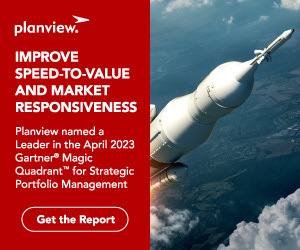This is the fifth and final post in our series on doing more portfolio management with less project data. You’ll find the whole series here.
Data needed at each level of portfolio management. The only required data are the three items in the orange Beginner box. How much further you go depends on your people, your portfolio, and your goals. See the first post in this series for more information.
Prioritizing Projects: Advanced Portfolio Management II
Once you’ve collected project information and gathered some information about project value, whether through a simple scoring process or in the form of complex financial metrics, you have enough information to build a prioritization (what we call a “bang-for-the-buck curve”)—see below for an example. This analysis is helpful for prioritizing projects in terms of value for money. Our video on project prioritization has all the lurid details on prioritization methods, best practices, and pitfalls.
The “bang-for-the-buck curve,” on the right, illustrating project value for money. The three charts on the left highlight different dimensions of portfolio balance: spending by division, spending by project phase, and short- and long-term revenue vs. corporate revenue target.
If you watched the video, you understand the meaning of the project frontier displayed in the chart to the the right of the figure, which sorts and plots projects from highest bang for the buck in the lower left to highest cost and lowest value in the upper right (orange dots represent funded projects). The frontier is all about value: if value were your only goal, you could draw a vertical line at your current year budget and fund all the projects to the left of that line. But as we’ve said before, portfolio management is not just about value—it’s also about balance across competing objectives. The charts on the left are all about balance; the top two detail the breakdown of spending by division and project phase, and the third compares the portfolio revenue forecast to corporate revenue targets. An interactive dashboard like this one (which is available in all Enrich Analytics offerings) can help your team navigate the trade-offs between value and balance.
Progressive Refinement: Start With What You Have, Build What You Need
Old hands may scoff at my characterizations of beginner/intermediate/advanced portfolio management. I can almost hear them saying, “Where is the discussion of optimization, of real options analysis, of uncertainty analysis? Everything in this post really falls under beginner portfolio management!” While I understand where they’re coming from, I think too many practitioners embrace an all-or-nothing philosophy about portfolio management; as a result many companies that would benefit from even the most fundamental portfolio management practices are scared away.
By now you won’t be surprised to hear me say that there’s value at each step along the journey. Value doesn’t need to be represented by a risk-adjusted net present value of cash flows, and cost doesn’t need to include (and probably shouldn’t) an hourly accounting for each person on the project for the next 18 months.
Don’t rush a decision to add detail to your data collection template. Every time you feel compelled to add something, resist the impulse until you calculate the trade-off between the value of that information (for improving decisions) and the difficulty of collecting, auditing, and reporting it. Consider also whether the additional information is likely to be used by your decision-making team (hopefully they are the ones asking for it in the first place) or whether that team is already drowning in a sea of much-too-detailed data.
Where to go from here
As I said in the first post, portfolio management is a journey, not a destination. You’ll probably refine your portfolio dataset, reporting, and process each business cycle until you retire or move on to the C-suite. There’s much more information available on this blog to help with this refinement, including posts on where traditional BI tools fall short, net present value, scenario analysis, scoring models, and facilitating portfolio reviews. And of course, we at Enrich would love to partner with you on your portfolio management journey.
At Enrich, we have deep experience helping companies benefit from portfolio management at every level of maturity. From startups with developing patent portfolios to the largest life science companies on the planet, we’ve deployed processes and tools that help them all make better investment decisions. If you’re interested in learning how our tools (Viewport and the Enrich Analytics Platform) can help you level-up on your portfolio management process, drop us a line.






